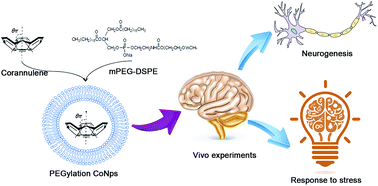PEGylation corannulene enhances response of stress through promoting neurogenesis†
Abstract
Carbon nanomaterials have been used to treat neurodegenerative diseases and neural disorders due to their diverse molecular structures. Corannulene is a three-dimensional π-bowl carbon nanomaterial that is different from planar PAHs, fullerenes and carbon nanotubes, but little is known about its biological functions. Herein, corannulene was functionalized with mPEG-DESP to prepare PEGylation corannulene nanoparticles (PEGylation CoNps). The synthesized PEGylation CoNps shows enhanced solubility and reduced aggregation when compared corannulene. Then, in vivo experiments were performed to determine the effects of PEGylation CoNps on the neural system. We found that PEGylation CoNps treatment increased short resting bouts, decreased locomotion activities and enhanced the response to stress. Most of these behavioral changes suggest that PEGylation CoNps lead to a greater reflection to stress, which is associated with neurotransmitter expression and neurogenesis. In line with the hypothesis, we found that PEGylation CoNps administration enhanced TH, DCX and MAP-2 expression in the hippocampus. These results indicated that PEGylation CoNps enhanced the neurogenesis of mice. Furthermore, pathological analysis showed that PEGylation CoNps caused little inflammation. These findings suggest that PEGylation CoNps are a potential functionalized carbon nanomaterial for promoting neurogenesis.



 Please wait while we load your content...
Please wait while we load your content...